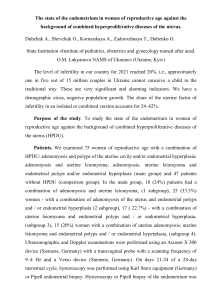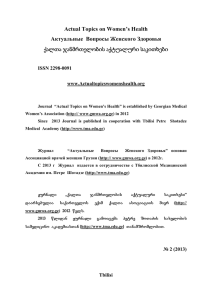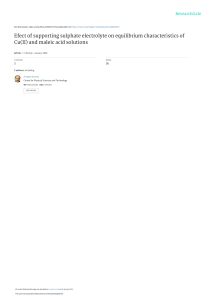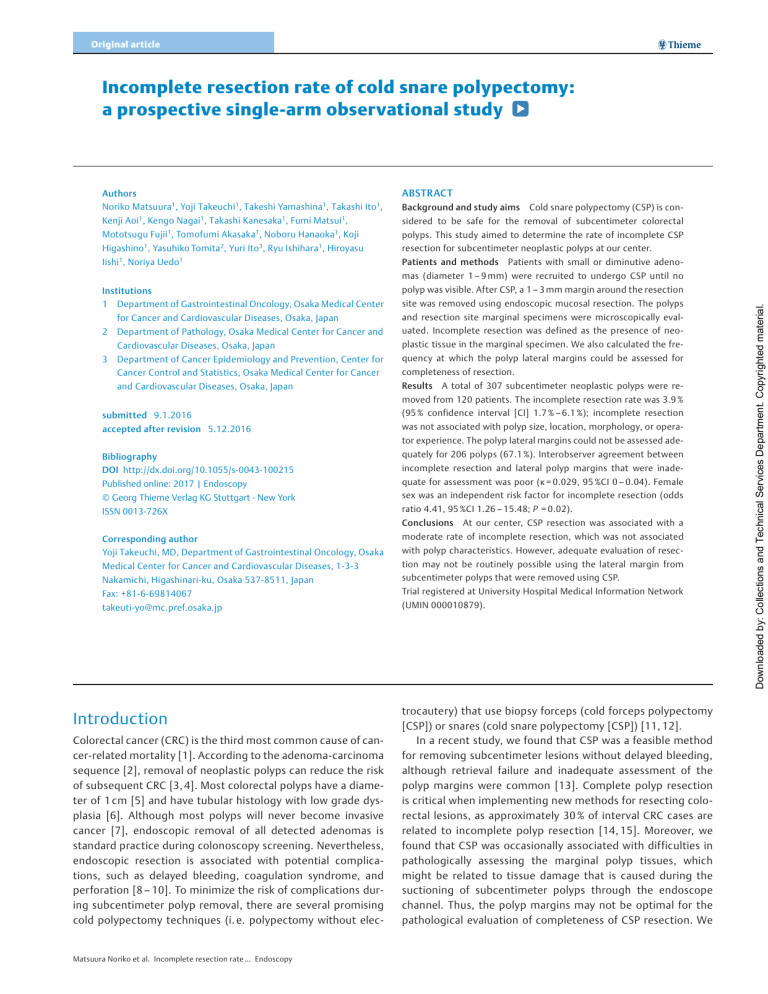
Original article Incomplete resection rate of cold snare polypectomy: a prospective single-arm observational study Authors ABSTRACT Noriko Matsuura 1, Yoji Takeuchi 1, Takeshi Yamashina1, Takashi Ito1, Background and study aims Kenji Aoi1, Kengo Nagai 1, Takashi Kanesaka 1, Fumi Matsui 1, sidered to be safe for the removal of subcentimeter colorectal Mototsugu Fujii 1, Tomofumi Akasaka1, Noboru Hanaoka 1, Koji polyps. This study aimed to determine the rate of incomplete CSP Higashino 1, Yasuhiko Tomita 2, Yuri Ito3, Ryu Ishihara 1, Hiroyasu resection for subcentimeter neoplastic polyps at our center. Iishi 1, Noriya Uedo 1 Patients and methods Cold snare polypectomy (CSP) is con- Patients with small or diminutive adeno- Institutions polyp was visible. After CSP, a 1 – 3 mm margin around the resection 1 Department of Gastrointestinal Oncology, Osaka Medical Center site was removed using endoscopic mucosal resection. The polyps for Cancer and Cardiovascular Diseases, Osaka, Japan and resection site marginal specimens were microscopically eval- Department of Pathology, Osaka Medical Center for Cancer and uated. Incomplete resection was defined as the presence of neo- Cardiovascular Diseases, Osaka, Japan plastic tissue in the marginal specimen. We also calculated the fre- Department of Cancer Epidemiology and Prevention, Center for quency at which the polyp lateral margins could be assessed for Cancer Control and Statistics, Osaka Medical Center for Cancer completeness of resection. and Cardiovascular Diseases, Osaka, Japan Results 2 3 A total of 307 subcentimeter neoplastic polyps were re- moved from 120 patients. The incomplete resection rate was 3.9 % submitted 9.1.2016 (95 % confidence interval [CI] 1.7 % – 6.1 %); incomplete resection accepted after revision 5.12.2016 was not associated with polyp size, location, morphology, or operator experience. The polyp lateral margins could not be assessed ade- Bibliography quately for 206 polyps (67.1 %). Interobserver agreement between DOI http://dx.doi.org/10.1055/s-0043-100215 incomplete resection and lateral polyp margins that were inade- Published online: 2017 | Endoscopy quate for assessment was poor (κ = 0.029, 95 %CI 0 – 0.04). Female © Georg Thieme Verlag KG Stuttgart · New York sex was an independent risk factor for incomplete resection (odds ISSN 0013-726X ratio 4.41, 95 %CI 1.26 – 15.48; P = 0.02). Conclusions At our center, CSP resection was associated with a Corresponding author moderate rate of incomplete resection, which was not associated Yoji Takeuchi, MD, Department of Gastrointestinal Oncology, Osaka with polyp characteristics. However, adequate evaluation of resec- Medical Center for Cancer and Cardiovascular Diseases, 1-3-3 tion may not be routinely possible using the lateral margin from Nakamichi, Higashinari-ku, Osaka 537-8511, Japan subcentimeter polyps that were removed using CSP. Fax: +81-6-69814067 Trial registered at University Hospital Medical Information Network [email protected] (UMIN 000010879). Introduction Colorectal cancer (CRC) is the third most common cause of cancer-related mortality [1]. According to the adenoma-carcinoma sequence [2], removal of neoplastic polyps can reduce the risk of subsequent CRC [3, 4]. Most colorectal polyps have a diameter of 1 cm [5] and have tubular histology with low grade dysplasia [6]. Although most polyps will never become invasive cancer [7], endoscopic removal of all detected adenomas is standard practice during colonoscopy screening. Nevertheless, endoscopic resection is associated with potential complications, such as delayed bleeding, coagulation syndrome, and perforation [8 – 10]. To minimize the risk of complications during subcentimeter polyp removal, there are several promising cold polypectomy techniques (i. e. polypectomy without elec- Matsuura Noriko et al. Incomplete resection rate … Endoscopy trocautery) that use biopsy forceps (cold forceps polypectomy [CSP]) or snares (cold snare polypectomy [CSP]) [11, 12]. In a recent study, we found that CSP was a feasible method for removing subcentimeter lesions without delayed bleeding, although retrieval failure and inadequate assessment of the polyp margins were common [13]. Complete polyp resection is critical when implementing new methods for resecting colorectal lesions, as approximately 30 % of interval CRC cases are related to incomplete polyp resection [14, 15]. Moreover, we found that CSP was occasionally associated with difficulties in pathologically assessing the marginal polyp tissues, which might be related to tissue damage that is caused during the suctioning of subcentimeter polyps through the endoscope channel. Thus, the polyp margins may not be optimal for the pathological evaluation of completeness of CSP resection. We Downloaded by: Collections and Technical Services Department. Copyrighted material. mas (diameter 1 – 9 mm) were recruited to undergo CSP until no Original article Patients and methods The fixed specimens were sectioned serially at 2 mm intervals, and then assessed by two experienced pathologists according to the Vienna classification of gastrointestinal epithelial neoplasia [20]. Cases of incomplete resection were identified based on the presence of any neoplastic tissue in the marginal specimen (▶ Fig. 1). All patients were followed up at our hospital within 1 month to identify any postoperative complications. Study participants Study outcomes This prospective, single-arm, observational study was performed at an endoscopy unit in a Japanese cancer referral center between March and December 2013. We recruited patients aged ≥ 20 years who were undergoing endoscopic colorectal polypectomy. The exclusion criteria were inflammatory bowel disease; familial polyposis; CRC with symptoms of stenosis, active bleeding, non-correctable coagulopathy, or severe organ failure; the use of anticoagulant therapy or antiplatelet therapy; and the absence of informed patient consent. For this study, we only considered lesions that were detected during colonoscopy and diagnosed as adenomas with a diameter of < 10 mm. The study protocol was approved by our institutional Ethics Committee, and was registered in the University Hospital Medical Network Clinical Trials Registry (UMINCTR, UMIN 000010879). All patients provided their written informed consent before participating in the study. The primary outcome was the rate of incomplete CSP resection (presence of neoplastic tissue in the resection site marginal specimens from pathologically confirmed neoplastic polyps). We also performed subgroup analyses according to sex, age (< 70 years/≥ 70 years), location (proximal/distal to the splenic flexure), morphology (protruded, sessile/superficial, elevated), polyp size (1 – 5 mm/6 – 9 mm), and operator experience (expert/senior resident). Experts were defined as having ≥ 10 years of endoscopy experience, and senior residents were defined as having < 10 years of experience. The secondary outcomes were defined as the incidences of immediate bleeding after the CSP (evident bleeding that required endoscopic hemostasis during the examination), delayed bleeding (evident bleeding that required endoscopic hemostasis after completion of the examination), pathological characteristics of polyps, and adverse events. Procedures Statistics Medications for bowel preparation and sedation were administered as previously reported [16, 17]. All procedures were performed by one of 11 experienced colonoscopists (4 experts and 7 senior residents). A standard or magnifying colonoscope was used in all cases (EVIS CF-240I, Q260DI, FH260AZI, H260AZI, HQ290 or PCF-Q260AZI; Olympus Medical Systems, Co., Ltd., Tokyo, Japan). Patients were assessed for polyp eligibility using narrow-band imaging (NBI), and the polyp size was measured using an open hexagonal electrosurgical snare (13 mm Captivator, Small hex type; Boston Scientific, Marlborough, Massachusetts, USA). The location, size, and macroscopic type of all detected lesions were documented according to the Paris classification [18]. Polyps that were diagnosed as Type 2 using the NBI International Colorectal Endoscopic (NICE) classification were resected using CSP [19]. CSP was performed using an electrosurgical snare (Captivator), and repeated CSP was allowed until no residual polyp was observed. After CSP, we injected normal saline into the submucosal space at the base of the resection site, and then removed the marginal specimen at the resection site using endoscopic mucosal resection (EMR) and the same snare that was used for CSP with a forced current mode (VIO 300D; ERBE, Tübingen, Germany). The aim of this step was to obtain 1 – 3 mm specimens of the clear margins from the surrounding non-neoplastic mucosa (▶ Fig. 1). The removed polyps and resection site marginal specimens were both retrieved via suction through the colonoscope working channel, and trapped in separate bottles that were attached to the suction tube (▶ Fig. 2, ▶ Video 1). The trapped specimens were stored in separate jars containing 10 % formalin. The required sample sizes (patients and polyps) were calculated using a simulation approach. The number of required polyps was estimated based on a Poisson distribution with 1.5 polyps per patient, based on the averages from our previous data. The reported rates of incomplete resection using the conventional method range from 3.4 % [21] to 6.8 % [5]. However, as an incomplete resection rate of 6.8 % for subcentimeter polyps seemed relatively high, we assumed a reference standard of 3.4 % and set the noninferiority margin as + 3.4 % (i. e. 6.8 %). Using the modified formula for calculating sample size in noninferiority single-arm studies [22], we estimated that a minimum of 310 polyps were needed to evaluate the noninferiority of the alternative method using a power value of 80 % and a one-sided alpha value of 5 %. A simulated sample size calculation was run 10 000 times using MATLAB version R2013a (MathWorks, Natick, Massachusetts, USA). Results for nonparametric data were reported as median (interquartile range or range). The data structures for the polyps were clustered according to patient, and we calculated the confidence intervals (CIs) by considering the intragroup correlations for single patients. Multivariate mixed-effect logistic regression analysis was used to evaluate the effects of the polyp characteristics. All variables that were significant in the univariate analyses were considered as potential risk factors in the multivariate logistic regression analysis. All statistical analyses were performed using Stata software version 13.1 (Stata Corp., College Station, Texas, USA). Matsuura Noriko et al. Incomplete resection rate … Endoscopy Downloaded by: Collections and Technical Services Department. Copyrighted material. thought therefore that the completeness of CSP resection should be assessed using the margins at the post-resection mucosal defect. The aim of the present study was to evaluate the rate of incomplete CSP resection using marginal specimens following CSP. V I D EO 1 Patients undergoing endoscopic colorectal polyp resection Polyps <10 mm and NICE Type 2 Cold snare polypectomy Additional endoscopic mucosal resection Retrieval Retrieval Removed polyp Marginal specimen ▶ Fig. 2 Flow diagram showing patient enrollment and study design. NICE, Narrow-band Imaging International Colorectal Endoscopic (classification). Results Patient recruitment and flow During the study period, 536 patients underwent colorectal endoscopic resection at our center, 398 of whom were excluded because they were participating in other clinical trials or because they did not fulfill the inclusion criteria. Thus, 138 patients were assessed for eligibility, and 6 patients were not in- Matsuura Noriko et al. Incomplete resection rate … Endoscopy ▶ Video 1: Study procedures. A narrow-band image of an 8-mm flat elevated lesion revealed adenoma. Cold snare polypectomy was performed and the resected specimen was retrieved. Endoscopic mucosal resection was subsequently performed at the polypectomy site, and the resected specimen was retrieved. cluded because they refused to participate or fulfilled the exclusion criteria, and 1 patient was subsequently excluded after enrollment because she refused to participate (▶ Fig. 3). Eventually, 131 patients were screened. We detected 375 subcentimeter polyps in the 131 patients who were eligible for analyses; 13 polyps were excluded because they were diagnosed as non-neoplastic lesions prior to Downloaded by: Collections and Technical Services Department. Copyrighted material. ▶ Fig. 1 Images from a complete resection case. a An 8-mm lesion protruding into the sigmoid colon. b Narrow-band imaging (NBI) of the lesion revealed that it was Type 2, according to the NBI International Colorectal Endoscopic classification. c Cold snare polypectomy was performed to retrieve the polyp. d The submucosa was injected with a saline solution. e Endoscopic mucosal resection was performed at the polypectomy site, and the marginal specimen was retrieved. f The histopathological specimen revealed a mucosal defect without any residual polyp. Original article Assessed for eligibility (138 patients) ▶ Table 1 Demographic and clinical characteristics of patients who had marginal resection site specimens analyzed after cold snare polypectomy. Excluded n = 6 (IBD 1; refusal 5) Patients, n 120 132 patients enrolled Male/female, n (%) 80 (66.7)/40 (33.3) Age, median (IQR), years 70 (64 – 75) Refusal after enrollment n = 1 131 patients screened NICE Type 1 n = 12; SMT n = 1 362 polyps (<10 mm) in 126 patients Total no. of polyps, n ▪ No. of polyps per patient, median (range), n 307 2 (1 – 15) Non-neoplastic polyp: 45 in 34 patients 317 neoplastic lesions in 123 patients EMR EMR failure: 5 polyps in 5 patients Retrieval failure: 2 polyp 2 patients Contamination: 1 polyp in 1 patient Protocol violation: 2 polyps in 2 patients 307 evaluable marginal specimens in 120 patients ▶ Fig. 3 Flow diagram showing the inclusions of patients and polyps. NICE, Narrow-band Imaging International Colorectal Endoscopic (classification); IBD, inflammatory bowel disease; SMT, submucosal tumor, EMR, endoscopic mucosal resection. CSP. Thus, 362 NICE Type 2 polyps were removed from 126 patients using CSP. Among the 362 subcentimeter polyps, residual polyp was endoscopically evident in 25 lesions (6.9 %), and these patients underwent additional CSP. EMR was then performed at all CSP sites. A total of 317 polyps (87.5 %) were pathologically diagnosed as neoplastic and the resection site marginal specimens were subsequently assessed, of which 10 could not be evaluated because of EMR or retrieval failure, contamination of the specimen after EMR, or protocol violation. Therefore, marginal specimens from 307 lesions in 120 patients were evaluated for resection completeness ( ▶ Fig. 3). The baseline characteristics of evaluable patients and lesions are shown in ▶ Table 1. Histopathological assessments of the polyp lateral margins revealed that 101 (32.9 %) contained no neoplastic tissue; the lateral margins of the remaining 206 polyps (67.1 %) could not be assessed. Study outcomes Among the 307 evaluable resection site marginal specimens obtained following EMR, histopathological examination revealed that 295 (96.1 %) did not contain neoplastic tissue and 12 lesions did contain neoplastic tissue; thus, the unadjusted rate of ▪ Cecum 19 (6.2) ▪ Ascending colon 74 (24.1) ▪ Transverse colon 111 (36.2) ▪ Descending colon 31 (10.1) ▪ Sigmoid colon 63 (20.5) ▪ Rectum 9 (2.9) Morphology, n (%) ▪ Protruded, sessile ▪ Superficial, elevated Polyp size, median (IQR), mm 237 (77.2) 70 (22.8) 4 (3 – 6) Polyps according to operator experience ▪ Experts (n = 4) 155 (50.5) ▪ Senior residents (n = 7) 152 (49.5) Histological type, n (%) ▪ Adenoma 305 (99.3) ▪ Low-grade/tubulovillous/high-grade 302 (98.4)/1 (0.3)/2 (0.7) ▪ Noninvasive carcinoma 2 (0.7) Polyp involvement in the polyp lateral margin, n (%) ▪ No neoplastic tissue in polyp lateral margin 101 (32.9) ▪ Inadequate assessment of the polyp lateral margin 206 (67.1) ▪ Neoplastic tissue in polyp lateral margin 0 IQR, interquartile range. incomplete CSP resection was 3.9 % (95 %CI 1.7 % – 6.1 %). All residual neoplastic tissues were found in the marginal mucosa, and not at the bottom of the mucosal defect. After we accounted for the intragroup correlations in single patients, the adjusted 95 %CI was 2.2 % – 6.9 %. For the 206 removed polyps with lateral margins that were inadequate for assessment, incomplete resection (as determined by the presence of neoplastic tissue in the corresponding resection site marginal specimen) was observed in 11 polyps (5.3 %). The sensitivity, specificity, and accuracy for inadequate polyp margins to assess resection completeness were 0.92 (95 %CI 0.65 – 0.99), 0.34 (95 %CI Matsuura Noriko et al. Incomplete resection rate … Endoscopy Downloaded by: Collections and Technical Services Department. Copyrighted material. Location, n (%) Cold snare polypectomy ▶ Table 2 Patient- and lesion-related factors according to incomplete resection or lateral polyp margins that were inadequate for assessment (307 polyps from 120 patients). Incomplete resection1 Inadequate polyp margin assessment 2 P κ (95 %CI) 12/307 (3.9) 206/307 (67.1) < 0.001 0.029 (0 – 0.04) 10/204 (4.9) 140/204 (68.6) < 0.001 2/103 (1.9) 66/103 (64.1) ▪ Protruded, sessile (0 – Is) 8/237 (3.4) 155/237 (65.4) < 0.001 ▪ Superficial, elevated (0 – IIa) 4/70 (5.7) 51/70 (72.9) < 0.001 ▪ 1 – 5 mm 7/223 (3.1) 145/223 (65.0) < 0.001 ▪ 6 – 9 mm 5/84 (6.0) 61/84 (72.6) < 0.001 ▪ Expert 3/155 (1.9) 91/155 (58.7) < 0.001 ▪ Senior resident 9/152 (5.9) 115/152 (75.7) < 0.001 Overall, n/N (%) Location, n/N (%) ▪ Proximal to splenic flexure ▪ Distal to splenic flexure Morphology, n/N (%) Operator experience, n/N (%) CI, confidence interval. 1 Determined histologically by the presence of neoplastic tissue in the resection site marginal specimen. 2 Determined histologically to be inadequate for the assessment of neoplasia. 0.33 – 0.34), and 0.36 (95 %CI 0.34 – 0.37), respectively. The kappa value for comparing lesions with incomplete resection and polyp margins that were inadequate for assessing resection completeness was 0.029 (95 %CI 0 – 0.04). The rates of incomplete resection and polyp margins that were inadequate for assessment were significantly different between the various subgroups ( ▶ Table 2). Factors associated with incomplete resection We did not observe any significant differences in age, location, morphology, size, or operator experience when we compared lesions with and without incomplete resection. However, female sex was an independent risk factor for incomplete resection in the multivariate analysis ( ▶ Table 3). Adverse events Immediate bleeding occurred in two patients (1.6 %) during the CSP, and hemostasis was achieved using endoclips in one case and using additional EMR in the other case. We applied prophylactic endoclips for four lesions and prophylactic coagulation for one lesion at the post-EMR site. One patient (0.8 %) presented with immediate post-polypectomy bleeding just after the additional EMR, and delayed bleeding occurred in six patients (4.8 %). All seven cases of immediate and delayed post-EMR bleeding were managed easily using endoscopic measures. All patients visited our outpatient department a median of 13 days (range 3 – 40 days) after the procedure. Five patients (4.0 %) complained of minor postoperative bleeding, which stopped spontaneously without any intervention. No other complications, such as perforation or post-polypectomy syndrome, were observed. Matsuura Noriko et al. Incomplete resection rate … Endoscopy Discussion This prospective observational study revealed that CSP was associated with a moderate rate of incomplete resection for subcentimeter colorectal polyps. Previous studies have compared the resection rates of CSP and CFP [23, 24], and found that CSP was associated with a higher rate of complete resection. However, as we thought that CSP could become a standard treatment for subcentimeter polyps, we aimed to identify the rate of incomplete CSP resection using resection site marginal specimens that were obtained using subsequent EMR after CSP. It is also important to note that the previous reports regarding incomplete polyp resection included hyperplastic polyps and sessile serrated adenoma/polyps [23, 24]. However, it is often difficult to evaluate the margins of these polyps using only endoscopy, or to determine whether incomplete resection in these cases is related to the actual CSP technique or to the difficulty in evaluating the polyp margins. Thus, polyps were limited to conventional adenomas in the present study, as these polyps have margins and residues that are more easily evaluated after CSP. In the present study, we performed CSP followed by subsequent EMR to leave a clear 1 – 3 mm margin of surrounding non-neoplastic mucosa (the resection site marginal specimens). In contrast, a previous study used multiple biopsies at the edges of the CSP site to evaluate the incomplete resection rate [23]; however, these procedures might not be sufficient for a thorough evaluation of CSP because the biopsy site can be deliberately manipulated to avoid the residual polyp. Thus, we believe that our use of subsequent EMR is more appropriate for the evaluation of CSP completeness (vs. multiple biopsies), al- Downloaded by: Collections and Technical Services Department. Copyrighted material. Size, n/N (%) Original article ▶ Table 3 Factors associated with incomplete resection. Univariate analysis Multivariate analysis OR (95 %CI) P OR (95 %CI) P ▪ Male 1 0.01 1 0.02 ▪ Female 4.59 (1.41 – 14.91) Sex 4.41 (1.26 – 15.48) Age, years ▪ < 70 1 ▪ ≥ 70 0.79 (0.24 – 2.60) 0.7 1 0.99 0.99 (0.28 – 3.52) Location 1 ▪ Distal to splenic flexure 0.38 (0.08 – 1.81) 0.23 1 0.24 0.38 (0.07 – 1.94) Morphology ▪ Protruded, sessile (0 – Is) 1 ▪ Superficial, elevated (0 – IIa) 1.71 (0.49 – 6.02) 0.4 1 0.74 1.25 (0.34 – 4.57) Size ▪ 1 – 5 mm 1 ▪ 6 – 9 mm 1.98 (0.59 – 6.60) 0.27 1 0.31 1.90 (0.55 – 6.59) Operator experience ▪ Expert 1 ▪ Senior resident 3.19 (0.84 – 12.05) 0.087 1 0.087 3.32 (0.84 – 13.17) OR, odds ratio; CI, confidence interval. though careful maneuvering is needed to perform the subsequent EMR at the resection site. We also used the forced coagulation mode for EMR to avoid bleeding, although it could be argued that the forced coagulation can cause tissue damage outside of the marginal specimen. Nevertheless, any residual polyp after CSP would be present immediately outside of the CSP site, which would correspond to approximately the center of the marginal specimen. Thus, we believe that any coagulation mode-related tissue damage would not affect the marginal assessment of resection completeness. Based on our moderate rate of incomplete resection (3.9 %), it is important to consider the possibility of this outcome. Although all residual polyps were discovered in the margin of the marginal specimen, and not in the mucosal defect itself [25], operators should carefully observe the surrounding mucosa after CSP, by washing any minor bleeding sites using a jet function. In addition, our subgroup analyses revealed that female sex was an independent risk factor for incomplete resection. Although we do not have a plausible explanation for this relationship, it is possible that this finding was biased by the small number of cases with incomplete resection. Nevertheless, care must be taken to detect residual polyp after CSP resection, especially when treating female patients. The present study revealed that the lateral margins of 67.1 % of the resected polyps were inadequate for assessment. Some endoscopists might consider this a significant issue, although this rate is comparable to the rate from our previous report [13]. We believe that the cause of specimens being inadequate for assessment might be related to retrieval through the working channel, a process that could damage the tissue and complicate precise histological assessment of the polyp lateral margins. However, only 3.9 % of the resection site marginal specimens contained residual neoplastic tissue, and the interobserver agreement was relatively poor for cases of incomplete resection and polyp lateral margins that were inadequate for assessment. Thus, findings from the polyp lateral margins were not related to incomplete resection, which may indicate that resection completeness cannot be evaluated routinely using the polyp lateral margins, and that it may not be necessary to consider the polyp margin after CSP resection of subcentimeter polyps. In this context, a “resect and discard” concept is currently a “hot topic” in this field of polyp management [26], and polyp involvement at the polyp margins cannot be assessed when the resected specimen is discarded. Given that our results suggest that polyp lateral margins are not useful in assessing resection completeness, our study findings can be used to support the “resect and discard” concept. This study has several limitations. First, the rate of incomplete CSP resection was not compared with the rates for other Matsuura Noriko et al. Incomplete resection rate … Endoscopy Downloaded by: Collections and Technical Services Department. Copyrighted material. ▪ Proximal to splenic flexure www.bsg.org.uk/clinical-guidance/endoscopy/colonoscopic-polypectomy-and-endoscopic-mucosal-resection-a-practical-guide.html Accessed 8 December 2014 [8] Tajiri H, Kitano S. Complications associated with endoscopic mucosal resection: definition of bleeding that can be viewed accidental. Dig Endosc 2004; 16: 134 – 136 [9] Yamashina T, Takeuchi Y, Uedo N et al. Features of electrocoagulation syndrome after endoscopic submucosal dissection for colorectal neoplasm. J Gastroenterol Hepatol 2016; 31: 615 – 620 [10] Oka S, Tanaka S, Kanao H et al. Current status in the occurrence of postoperative bleeding, perforation and residual/local recurrence during colonoscopic treatment in Japan. Dig Endosc 2010; 22: 376 – 380 [11] Tappero G, Gaia E, De Giuli P et al. Cold snare excision of small colorectal polyps. Gastrointest Endosc 1992; 38: 310 – 313 [12] Repici A, Hassan C, Vitetta E et al. Safety of cold polypectomy for <10 mm polyps at colonoscopy: a prospective multicenter study. Endoscopy 2012; 44: 27 – 31 [13] Takeuchi Y, Yamashina T, Matsuura N et al. Feasibility of cold snare polypectomy in Japan: a pilot study. World J Gastrointest Endosc 2015; 7: 1250 – 1256 [14] Farrar WD, Sawhney MS, Nelson DB et al. Colorectal cancers found after a complete colonoscopy. Clin Gastroenterol Hepatol 2006; 4: 1259 – 1264 [15] Pabby A, Schoen RE, Weissfeld JL et al. Analysis of colorectal cancer occurrence during surveillance colonoscopy in the dietary Polyp Prevention Trial. Gastrointest Endosc 2005; 61: 385 – 391 [16] Takeuchi Y, Inoue T, Hanaoka N et al. Autofluorescence imaging with a transparent hood for detection of colorectal neoplasms: a prospective, randomized trial. Gastrointest Endosc 2010; 72: 1006 – 1013 [17] Takeuchi Y, Inoue T, Hanaoka N et al. Surveillance colonoscopy using a transparent hood and image-enhanced endoscopy. Dig Endosc 2010; 22: 47 – 53 [18] Participants in the Paris Workshop. The Paris endoscopic classification of superficial neoplastic lesions: esophagus, stomach, and colon – November 30 to December 1, 2002. Gastrointest Endosc 2003; 58: 3 – 43 Competing interests [19] Hewett DG, Kaltenbach T, Sano Y et al. Validation of a simple classification system for endoscopic diagnosis of small colorectal polyps using narrow-band imaging. Gastroenterology 2012; 143: 599 – 607 None [20] Dixon MF. Gastrointestinal epithelial neoplasia: Vienna revisited. Gut 2002; 51: 130 – 131 References [1] Siegel R, Naishadham D, Jemal A. CA Cancer. J Clin 2012; 62: 10 – 29 [2] Morison B. President’s address: the polyp-cancer sequence in the large bowel. Proc R Soc Med 1974; 67: 451 – 457 [3] Winawer SJ, Zauber AG, Ho MN et al. Prevention of colorectal cancer by colonoscopic polypectomy. The National Polyp Study Workgroup. N Engl J Med 1993; 329: 1977 – 1981 [4] Zauber AG, Winawer SJ, O’Brien MJ et al. Colonoscopic polypectomy and long-term prevention of colorectal-cancer deaths. N Engl J Med 2012; 366: 687 – 696 [5] Pohl H, Srivastava A, Bensen SP et al. Incomplete polyp resection during colonoscopy-results of the complete adenoma resection (CARE) study. Gastroenterology 2013; 144: 74 – 80 [6] Gupta N, Bansal A, Rao D et al. Prevalence of advanced histological features in diminutive and small colon polyps. Gastrointest Endosc 2012; 75: 1022 – 1030 [7] British Society of Gastroenterology. Colonoscopic polypectomy and endoscopic mucosal resection: a practical guide. Available at: http:// Matsuura Noriko et al. Incomplete resection rate … Endoscopy [21] Sugisaka H, Ikegami M, Kijima H et al. Pathological features of remnant or recurrent colonic lesions after endoscopic mucosal resection. Endoscopia Digestive 2003; 15: 951 – 956 [22] Schoenfeld D. Statistical considerations for pilot studies. Int J Radiat Oncol Biol Phys 1980; 6: 371 – 374 [23] Lee CK, Shim JJ, Jang JY. Cold snare polypectomy vs. cold forceps polypectomy using double-biopsy technique for removal of diminutive colorectal polyps: a prospective randomized study. Am J Gastroenterol 2013; 108: 1593 – 1600 [24] Kim JS, Lee B1, Choi H et al. Cold snare polypectomy versus cold forceps polypectomy for diminutive and small colorectal polyps: a randomized controlled trial. Gastrointest Endosc 2015; 81: 741 – 747 [25] Tutticci N, Burgess NG, Pellise M et al. Characterization and significance of protrusions in the mucosal defect after cold snare polypectomy. Gastrointest Endosc 2015; 82: 523 – 528 [26] Takeuchi Y, Hanafusa M, Kanzaki H et al. An alternative option for “resect and discard” strategy, using magnifying narrow-band imaging: a prospective “proof-of-principle” study. J Gastroenterol 2015; 50: 1017 – 1026 [27] Horiuchi A, Hosoi K, Kajiyama M et al. Prospective, randomized comparison of 2 methods of cold snare polypectomy for small colorectal polyps. Gastrointest Endosc 2015; 82: 686 – 692 Downloaded by: Collections and Technical Services Department. Copyrighted material. techniques (e. g. conventional EMR or hot biopsy), because we cannot confirm the safety of the additional EMR after conventional EMR as a reference standard. However, we believe that similar incomplete CSP resection rates in previous reports validate our present results [23, 24]. Second, we evaluated the histological results of resected specimens from the EMR site, but we did not evaluate the rate of residual polyps after CSP at the follow-up endoscopy. Third, some of the patients had multiple lesions, which we resected and retrieved using a polyp trap. Thus, we cannot exclude the possibility that one specimen might have become contaminated by the previous specimen, and it is possible that the rate of incomplete CSP resection found in the study was higher than the actual rate of incomplete resection. Fourth, we used a nondedicated conventional snare in this study because it would have been too expensive to use a dedicated snare for CSP and then a nondedicated conventional snare for conventional EMR. Thus, it is possible that we might have achieved a lower incomplete resection rate if we had used a dedicated snare [27]. Fifth, we used a single-center design, which is associated with known risks of bias. Therefore, large-scale, multicenter, prospective studies are needed to investigate the actual rate of residual polyps after CSP. In conclusion, this study revealed an incomplete resection rate of 3.9 % (95 %CI 1.7 % – 6.1 %) when we used CSP to remove subcentimeter colorectal polyps at our center. However, the polyp lateral margin evaluability was not related to the rate of incomplete resection, and it may not be possible to routinely and adequately assess the completeness of polyp resection using the polyp lateral margins. Therefore, the resection site margin should be carefully examined to confirm whether radical resection has been achieved when using CSP to remove subcentimeter colorectal polyps.

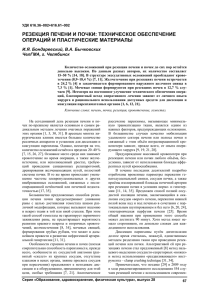

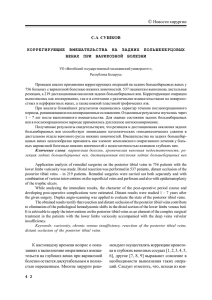
2(H2O)22](http://s1.studylib.ru/store/data/002418956_1-7fb9af4b7d45defefea274029e11459b-300x300.png)
